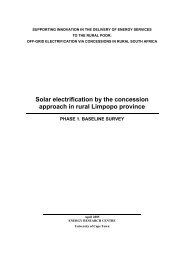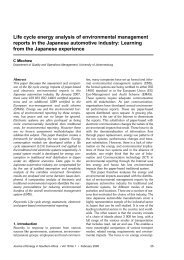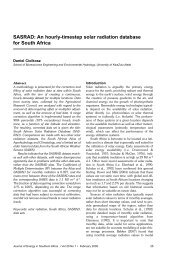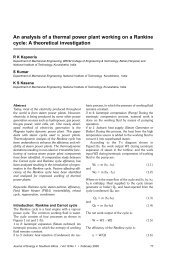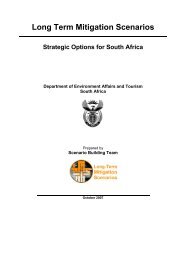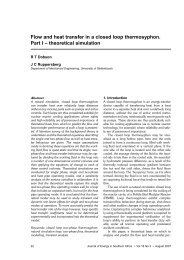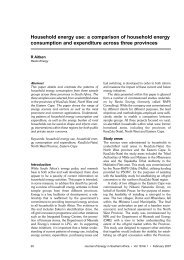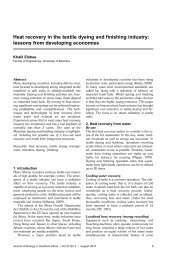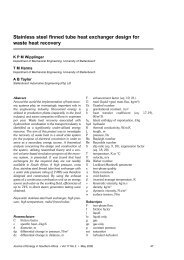Climate variability, climate change and water resource strategies for ...
Climate variability, climate change and water resource strategies for ...
Climate variability, climate change and water resource strategies for ...
Create successful ePaper yourself
Turn your PDF publications into a flip-book with our unique Google optimized e-Paper software.
<strong>Climate</strong> <strong>variability</strong>, <strong>climate</strong> <strong>change</strong> <strong>and</strong> <strong>water</strong> <strong>resource</strong> <strong>strategies</strong> <strong>for</strong> small municipalities<br />
In some cases, however, <strong>water</strong> tankering has become a regular <strong>for</strong>m of <strong>water</strong> supply, as in the case<br />
of Van Wyksvlei (Kareeberg). During 2003 <strong>water</strong> was supplied by tanker from Carnarvon (60 km<br />
away) <strong>and</strong> Copperton to Van Wyksvlei <strong>and</strong> it was proposed to continue with this practice until a<br />
more permanent solution had been developed (Department of Housing <strong>and</strong> Local Government<br />
2005b).<br />
7.1.2.3 Drought relief funding <strong>and</strong> aid schemes<br />
The Department of Housing <strong>and</strong> Local Government in the Northern Cape Province holds regular<br />
(monthly) Provincial Drought Task Team Meetings. These meetings are attended by Department of<br />
Housing (DoH), DWAF, Department of Agriculture, Department of Health <strong>and</strong> Social Services <strong>and</strong><br />
the local district municipalities. This Task Team co-ordinates the drought relief ef<strong>for</strong>ts <strong>for</strong> the<br />
province <strong>and</strong> keeps track of the allocation of relief funding from the different departments. The<br />
drought of 2003/2004 brought the critical <strong>resource</strong> problems to DPLG’s attention <strong>and</strong> ensured that<br />
limited funding was made available.<br />
In most cases, the drought relief funding has been used to expedite the delivery of basic services <strong>and</strong><br />
provide co-funding <strong>for</strong> bulk infrastructure to remote areas. An example of this was the importation<br />
of <strong>water</strong> from the Vaal <strong>and</strong> the Gariep rivers via pipelines. This was relatively costly <strong>and</strong> the<br />
majority of this funding was through CMIP, the DWAF Water Services CAPEX programme <strong>and</strong> the<br />
2003/2004 Drought Relief Programme (van Dyk et al. 2005).<br />
In 2004/5 the Department of Agriculture allocated R1 million to the Northern Cape <strong>for</strong> aid to<br />
farmers that experienced critical <strong>water</strong> shortages <strong>for</strong> stock <strong>water</strong>ing <strong>and</strong> human consumption on<br />
privately owned farms <strong>and</strong> on communal l<strong>and</strong> (Department of Agriculture 2005). The main<br />
condition set by the National Department of Agriculture to qualify <strong>for</strong> aid is that the <strong>water</strong> supply<br />
should be less than that needed <strong>for</strong> a third of the carrying capacity of the farm <strong>for</strong> stock <strong>water</strong> plus<br />
<strong>water</strong> needed <strong>for</strong> human consumption. This has been based on:<br />
• small stock unit: 5 litres per day;<br />
• large stock unit: 50 litres per day;<br />
• human consumption: 20 litres per day.<br />
The amount allocated <strong>for</strong> human consumption appears to be less than the 25 litres per person<br />
recommended by DWAF. Also, the maximum subsidy <strong>for</strong> drilling a borehole <strong>and</strong> fitting a pump is<br />
R30 000, which means that only 30 applicants can be helped with the R1 million allocated. This<br />
allocation is inadequate given that 50 applications <strong>for</strong> Siy<strong>and</strong>a <strong>and</strong> Namaqua alone were received<br />
(Department of Agriculture 2005).<br />
7.1.3 Rain<strong>water</strong> harvesting<br />
Whilst not considering the agricultural benefits of surface <strong>water</strong> harvesting, there is also the benefit<br />
of improving the recharge of underground <strong>water</strong>, either by natural infiltration of the soil or by<br />
artificial recharge methods. The effectiveness of this does, however, depend on the aquifer type. In<br />
the southern tributary catchments of the Lower Orange <strong>water</strong> management area, the unique use of<br />
soil embankments has been employed as a means of rain<strong>water</strong> harvesting (DWAF 2004b). This<br />
practice enables additional recharging of the aquifer <strong>and</strong> reduces the runoff. Appropriate measures<br />
are required to manage the impacts of these “soomwalle” on downstream users (BKS (Pty) Ltd<br />
2003).<br />
At a domestic level, rain<strong>water</strong> harvesting from roofs is an effective way of augmenting drinking<br />
<strong>water</strong>, <strong>water</strong>ing gardens <strong>and</strong> filling up swimming pools.<br />
In the Northern Cape the following towns have implemented domestic rain<strong>water</strong> harvesting<br />
schemes: Namaqual<strong>and</strong>: Rietpoort, Waqu, Paulshoek, Lepelfontein, <strong>and</strong> Sutherl<strong>and</strong> recently spent<br />
R33 000 on rain<strong>water</strong> harvesting equipment <strong>for</strong> domestic housing (Visser 2004; Department of<br />
Housing <strong>and</strong> Local Government 2005b) .<br />
7.1.4 Desalination<br />
Desalination offers an opportunity <strong>for</strong> coastal municipalities to convert sea<strong>water</strong> into fresh<strong>water</strong>.<br />
Presently this technology is both a capital- <strong>and</strong> energy-intensive source of fresh<strong>water</strong> that would<br />
make the cost of <strong>water</strong> out of the reach of most local municipalities – in some case 3-4 times the cost<br />
32




